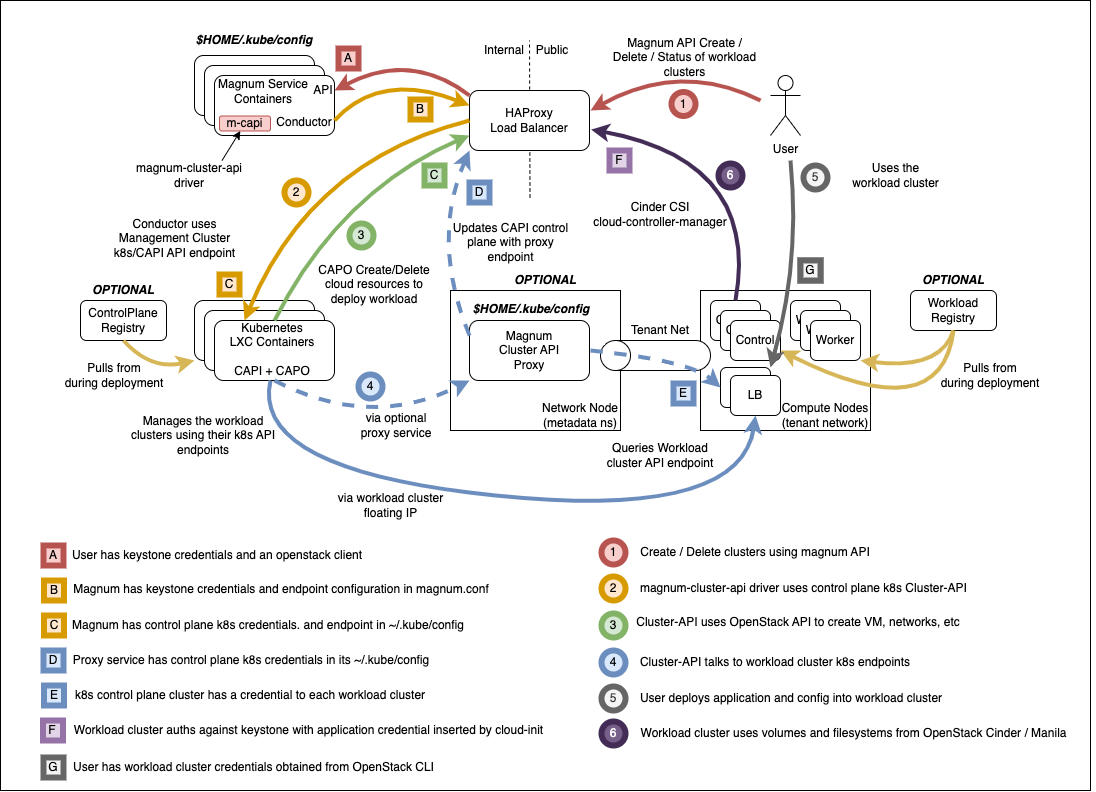In case your hostname contains upper-level symbols, they will be all lowered in k8s cluster. With that it's important to ensure that the expected hostname used in roles is always lowercase one. Change-Id: I31e483cc7766e26f932984067daee6983122db10
Install vexxhost magnum-cluster-api driver
About this repository
This repository includes playbooks and roles to deploy the Vexxhost magnum-cluster-api driver for the OpenStack Magnum service.
The playbooks create a complete deployment including the control plane k8s cluster which should result in a ready-to-go experience for operators.
The following architectural features are present:
- The control plane k8s cluster is an integral part of the openstack-ansible deployment, and forms part of the foundational components alongside mariadb and rabbitmq.
- The control plane k8s cluster is deployed on the infra hosts and integrated with the haproxy loadbalancer and OpenStack internal API endpoint, and not exposed outside of the deployment
- SSL is supported between all components and configuration is possible to support different certificate authorities on the internal and external loadbalancer endpoints.
- Control plane traffic can stay entirely within the management network if required
- The magnum-cluster-api-proxy service is deployed to allow communication between the control plane and workload clusters when a floating IP is not attached to the workload cluster.
- It is possible to do a completely offline install for airgapped environments
The magnum-cluster-api driver for magnum can be found here https://github.com/vexxhost/magnum-cluster-api
Documentation for the Vexxhost magnum-cluster-api driver is here https://vexxhost.github.io/magnum-cluster-api/
The ansible collection used to deploy the controlplane k8s cluster is here https://github.com/vexxhost/ansible-collection-kubernetes
The ansible collection used to deploy the container runtime for the controlplane k8s cluster is here https://github.com/vexxhost/ansible-collection-containers
These playbooks require Openstack-Ansible Caracal or later.
Highlevel overview of the Magnum infrastructure these playbooks will build and operate against.
Pre-requisites
- An existing openstack-ansible deployment
- Control plane using LXC containers, bare metal deployment is not tested
- Core openstack services plus Octavia
OpenStack-Ansible Integration
The playbooks are distributed as an ansible collection, and integrate with Openstack-Ansible by adding the collection to the deployment host by adding the following to /etc/openstack_deploy/user-collection-requirements.yml under the collections key.
../../mcapi_vexxhost/playbooks/files/openstack_deploy/user-collection-requirements.yml
The collections can then be installed with the following command:
cd /opt/openstack-ansible openstack-ansible scripts/get-ansible-collection-requirements.yml
The modules in the kubernetes collection require an additional python module to be present in the ansible-runtime python virtual environment. Specify this in /etc/openstack_deploy/user-ansible-venv-requirements.txt
../../mcapi_vexxhost/playbooks/files/openstack_deploy/user-ansible-venv-requirements.txt
OpenStack-Ansible configuration for magnum-cluster-api driver
Specify the deployment of the control plane k8s cluster in /etc/openstack_deploy/env.d/k8s.yml
../../mcapi_vexxhost/playbooks/files/openstack_deploy/env.d/k8s.yml
Define the physical hosts that will host the controlplane k8s cluster in /etc/openstack_deploy/conf.d/k8s.yml. This example is for an all-in-one deployment and should be adjusted to match a real deployment with multiple hosts if high availability is required.
../../mcapi_vexxhost/playbooks/files/openstack_deploy/conf.d/k8s.yml
Integrate the control plane k8s cluster with the haproxy loadbalancer in /etc/openstack_deploy/group_vars/k8s_all/haproxy_service.yml
../../mcapi_vexxhost/playbooks/files/openstack_deploy/group_vars/k8s_all/haproxy_service.yml
Configure the LXC container that will host the control plane k8s cluster to be suitable for running nested containers in /etc/openstack_deploy/group_vars/k8s_all/main.yml
../../mcapi_vexxhost/playbooks/files/openstack_deploy/group_vars/k8s_all/main.yml
Set up config-overrides for the magnum service in /etc/openstack_deploy/user_variables_magnum.yml. Adjust the images and flavors here as necessary, these are just for demonstration. Upload as many images as you need for the different workload cluster kubernetes versions.
Attention must be given to the SSL configuration. Users and workload clusters will interact with the external endpoint and must trust the SSL certificate. The magnum service and cluster-api can be configured to interact with either the external or internal endpoint and must trust the SSL certificiate. Depending on the environment, these may be derived from different certificate authorities.
../../mcapi_vexxhost/playbooks/files/openstack_deploy/user_variables_z_magnum.yml
Set up config-overrides for the control plane k8s cluster in /etc/openstack_deploy/user_variables_k8s.yml` These variables integrate the control plane k8s deployment with the rest of the openstack-ansible deployment.
../../mcapi_vexxhost/playbooks/files/openstack_deploy/user_variables_k8s.yml
Run the deployment
For a new deployment
Run the OSA playbooks/setup.yml playbooks as usual, following the normal deployment guide.
Run the magnum-cluster-api deployment
openstack-ansible osa_ops.mcapi_vexxhost.k8s_install
For an existing deployment
Ensure that the python modules required for ansible are present:
./scripts/bootstrap-ansible.sh
Alternatively, without re-running the bootstrap script:
/opt/ansible-runtime/bin/pip install docker-image-py
Add the magnum-cluser-api driver to the magnum service
openstack-ansible playbooks/os-magnum-install.yml
Create the k8s control plane containers
openstack-ansible playbooks/lxc-containers-create.yml --limit k8s_all
Run the magnum-cluster-api deployment
openstack-ansible osa_ops.mcapi_vexxhost.k8s_install
Optionally run a functional test of magnum-cluster-api
This can be done quickly using the following playbook
openstack-ansible osa_ops.mcapi_vexxhost.functional_test
This playbook will create a neutron public network, download a prebuilt k8s glance image, create a nova flavor and a magnum cluster template.
It will then deploy the workload k8s cluster using magnum, and run a sonobouy "quick mode" test of the workload cluster.
This playbook is intended to be used on an openstack-ansible all-in-one deployment.
Use Magnum to create a workload cluster
Upload Images
Create a cluster template
Create a workload cluster
Optional Components
Deploy the workload clusters with a local registry
TODO - describe how to do this
Deploy the control plane cluster from a local registry
TODO - describe how to do this
Use of magnum-cluster-api-proxy
TODO - describe what this is for
Troubleshooting
Local testing
An OpenStack-Ansible all-in-one configured with Magnum and Octavia is capable of running a functioning magnum-cluster-api deployment.
Sufficient memory should be available beyond the minimum 8G usually required for an all-in-one. A multinode workload cluster may require nova to boot several Ubuntu images in addition to an Octavia loadbalancer instance. 64G would be an appropriate amount of system RAM.
There also must be sufficient disk space in /var/lib/nova/instances to support the required number of instances - the normal minimum of 60G required for an all-in-one deployment will be insufficient, 500G would be plenty.
